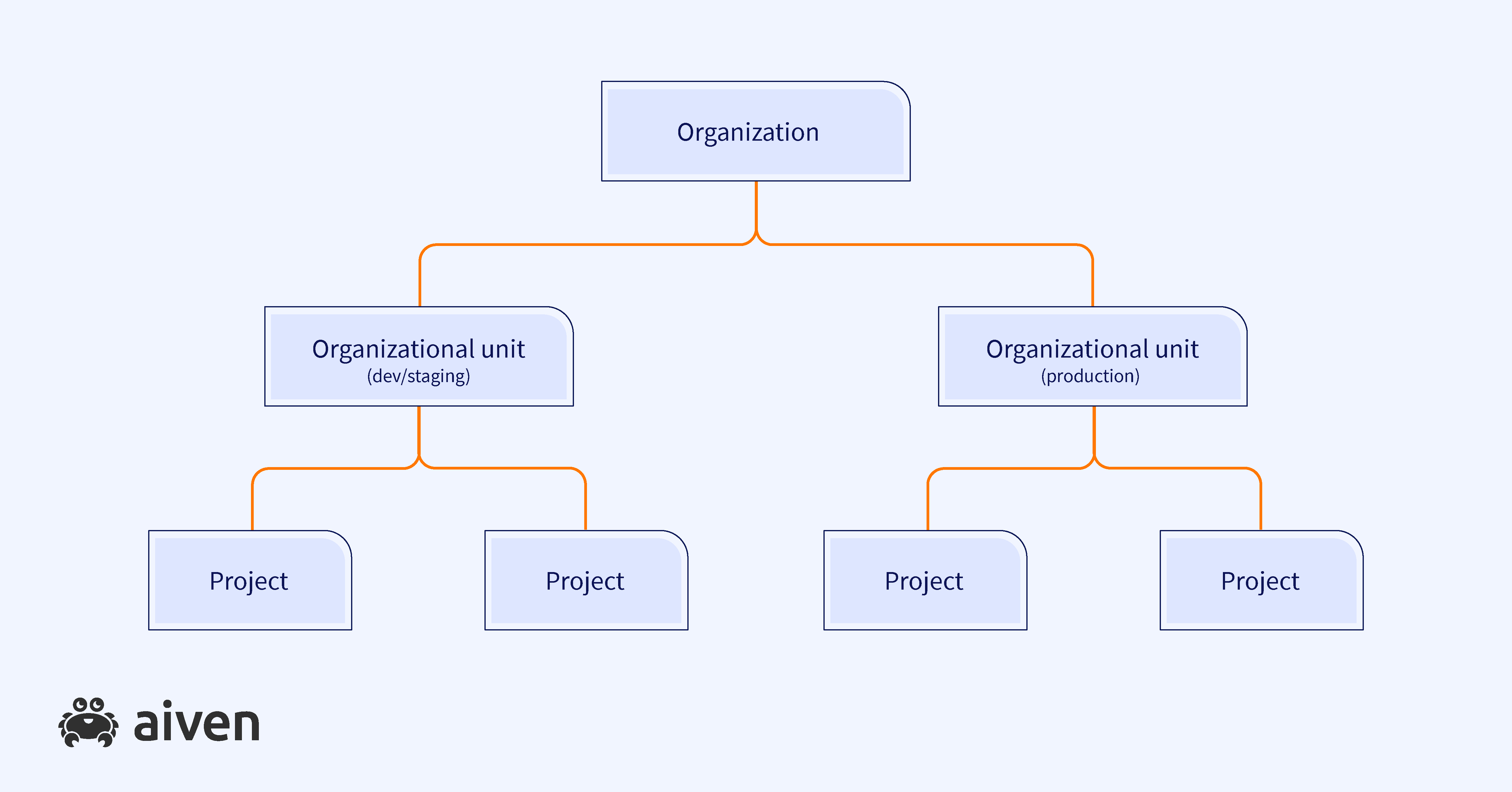Organization hierarchy and access#
The Aiven platform uses organizations, organizational units, and projects to organize services and access to those services. Learn how you can use these effectively to accommodate your organization’s structure.

Organizations and organizational units#
Organizations and organizational units are collections of projects. When you sign up to Aiven, an organization is created for you.
You can use your organization to create a hierarchical structure that fits your needs. Organizational units can be nested within an organization, adding another level to group your projects. This gives you greater flexibility to organize your infrastructure based on your specific use cases. For example, you can easily split production and testing workloads into different organizational units.
Grouping your projects in organizations and organizational units lets you centrally manage settings like:
Authentication methods: Only available on the organization level
Access control lists (ACLs): Can be set on all levels (organization, organizational unit, and project)
ACLs for service plans are inherited, meaning all projects within an organization or organizational unit will have the same service plan.
Groups: Managed at the organization level and assigned to projects
Support contracts: Specific to a single organization and cannot be shared between them
Billing groups: Specific to a single organization and cannot be shared between them
Super admin#
Super admin have full access to the organization, including all organizational units, projects, and services. Users are automatically made super admin when they create an organization, and they can make other users super admin.
Super admin are the same as account owners. Adding a user to the account owners team makes them a super admin. Likewise, when you make a user a super admin, they are added to the account owners team.
Projects#
Projects are collections of services and user permissions. Each project must have a unique name. You can group your services however you see fit. These are some examples of how customers organize their services:
Single project: One project containing services that are distinguished by their names. For example, services are named based on the type of environment:
demo_pg_project.postgres-prodanddemo_pg_project.postgres-staging.Environment-based: Each project represents a deployment environment, for example:
dev,qa, andproduction. This allows you to apply uniform network security, such as the use of virtual private clouds, to all services within each environment. This also gives you more granular user permissions, such as developer access to production infrastructure.Project-based: Each project contains all the services for an internal project, with naming that highlights the relevant environment; for example:
customer-success-prodandbusiness-analytics-test.
Project and service access management#
You can grant users access to services at the project level by adding them as project members, either individually or in groups.
The Aiven platform lets you use a mix of group and individual access rights for projects. One example of this is to grant read-only access to all projects in an organization or unit for a group of external contractors.
Groups#
Organization users can be added to groups, making it easy to control access to the services in a project. When you add a group to a project, you also select the role for that group. This role gives all users in that group the same level of access to all services in the project.
Best practices for organizations#
Small organizations
For smaller organizations that have a limited number of projects we recommend consolidating all of your projects within one organization. This will make it easier for your teams to navigate between projects and services.
Good naming conventions also help with finding projects and services. For example, you can include the environment type - dev, prod, etc. - at the beginning of project names.
Medium organizations
For more complex cases, it’s helpful to take advantage of the organizational units. Organizational units let you collect together related projects.
You could, for example, group projects into organizational units that correspond to your internal departments. Alternatively, you could group them by categories like testing, staging, and production environments.
Large organizations
For large organizations, it’s best to keep all of your projects in organizational units instead of organizations. By keeping all of your projects in organizational units you can centrally manage things like support contracts and billing groups for each group of projects.

